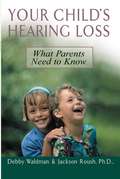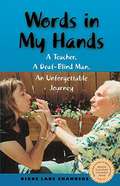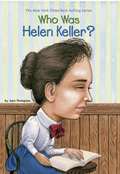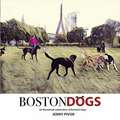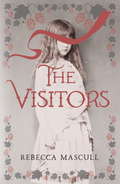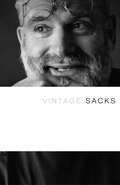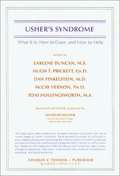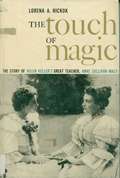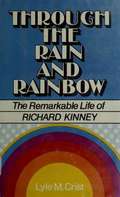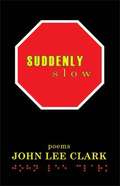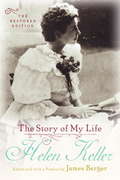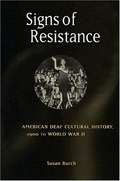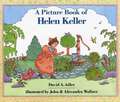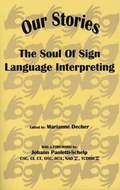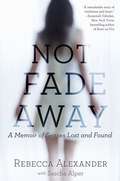Special Collections
Deaf-Blind Special Collection
Description: A collection featuring biographies, fiction and non-fiction by and about members of the deaf-blind community. For books by and about members of the deaf community, visit: https://www.bookshare.org/browse/collection/249852 #disability
- Table View
- List View
Your Child's Hearing Loss
by Debby Waldman and Jackson RoushFrom a mother whose daughter has hearing loss, and an audiologist with more than twenty-five years of experience with deaf and hard-of-hearing children and their families, this comprehensive volume offers parents what they need to know from day-to-day practical solutions to technical information to emotional support.
Words in My Hands
by Diane ChambersBert Riedel, an 86-year-old deaf-blind pianist, cut off from the world since age 45, discovers a new life through hand-over-hand sign, taught to him by the author.
Who Was Helen Keller?
by Gare ThompsonAt age two, Helen Keller became deaf and blind. She lived in a world of silence and darkness and she spent the rest of her life struggling to break through it. But with the help of teacher Annie Sullivan, Helen learned to read, write, and do many amazing things.
Walk In My Shoes
by ed. Charlotte J. DewittUsher Syndrome is a rare genetic disease that causes deafblindness. This anthology includes 27 authors writing about their experiences.
Walking Free
by Rosezelle Boggs-Qualls and Darryl C. GreeneBiography of a deaf-blind woman who spent 18 years isolated in a mental hospital before gaining her freedom, earning a college degree and working as a social worker in northeast Ohio. The co-authors are a deaf social worker and blind pastor.
The Visitors
by Rebecca MascullImagine if you couldn't seecouldn't hearcouldn't speak...Then one day somebody took your hand and opened up the world to you.Adeliza Golding is a deafblind girl, born in late Victorian England on her father's hop farm. Unable to interact with her loving family, she exists in a world of darkness and confusion; her only communication is with the ghosts she speaks to in her head, who she has christened the Visitors. One day she runs out into the fields and a young hop-picker, Lottie, grabs her hand and starts drawing shapes in it. Finally Liza can communicate.Her friendship with her teacher and with Lottie's beloved brother Caleb leads her from the hop gardens and oyster beds of Kent to the dusty veldt of South Africa and the Boer War, and ultimately to the truth about the Visitors.
Vintage Sacks
by Oliver SacksOliver Sacks' empathetic understanding and compelling storytelling ability have turned his accounts of his patients and his own life into literature, as evidenced in "Uncle Tungsten," "Stinks and Bangs," and "Cannery Row" from Uncle Tungsten; the Foreword and "Rose R." from Awakenings; "A Deaf World" from Seeing Voices; and excerpts from "Island Hopping" and "Pingelap" from The Island of the Colorblind.
Usher's Syndrome
by Earlene Duncan and Hugh T. Prickett and Dan Finkelstein and Mccay Vernon and Toni HollingsworthDescribes what Usher's syndrome is, how it impacts a person's life, and ways to cope with this dual disability.
Unaccompanied Sonata & Other Stories
by Orson Scott CardShort stories by this prolific and award winning science fiction author. The title story is about truly unique music and its guardians, deafness and blindness.
The Touch of Magic
by Lorena A. HickokThe story of Helen Keller's great teacher, Anne Sullivan Macy
Through the Rain and Rainbow
by Lyle M. CristRichard Kenny lost his sight at age seven. He spent his childhood adjusting to and overcoming blindness. He entered college but had to drop out in his second year when his hearing failed.
The next ten years contained motes of both great anguish and sweet victory as he adjusted to being totally deaf-blind. With perseverance, the support of family and friends, and the counsel of such leaders as Helen Keller and other workers for the deaf and blind, Kenny became the third deaf-blind person in history to earn a college degree. He married, became a father, traveled and wrote.
Suddenly Slow
by John Lee ClarkThis collection of poems opens with a stumble: 'It was not there / until I tripped over it.' But this is fitting because John Lee Clark bounces back, as he always does, artfully and unexpectedly, to make an astonishing statement. Snowballs, his long white cane, pears, Braille, bedsheets, sign language, and even morning light come alive in this deaf-blind poet's hands like they have never before. Thanks to his sparkling language, his intellectual playfulness, and his capacity for wonder, together with his unique perceptions of life, his poems add a much-needed new wrinkle to the lexicon of imagination. What he reflects on, others cannot see in the same way again, and that includes the poet himself: We understand that he is like the rest of humankind in all the most important ways.
The Story of My Life
by Helen KellerAn American classic rediscovered by each generation, The Story of My Life is Helen Keller's account of her triumph over deafness and blindness. Popularized by the stage play and movie The Miracle Worker, Keller's story has become a symbol of hope for people all over the world.
This book-published when Keller was only twenty-two-portrays the wild child who is locked in the dark and silent prison of her own body. With an extraordinary immediacy, Keller reveals her frustrations and rage, and takes the reader on the unforgettable journey of her education and breakthroughs into the world of communication.
From the moment Keller recognizes the word "water" when her teacher finger-spells the letters, we share her triumph as "that living word awakened my soul, gave it light, hope, joy, set it free!" An unparalleled chronicle of courage, The Story of My Life remains startlingly fresh and vital more than a century after its first publication, a timeless testament to an indomitable will.
The Story of Esther Costello
by Nicholas MonsarratEsther Costello, born on a peasant farm in Ireland, became a deaf-blind-mute after an explosion. She was discovered and saved from her predicament by Mrs. Bannister, a wealthy American. Mrs. Bannister rescued her, and brought her to Boston shortly after the 2nd World War. Mrs. Bannister taught Esther how to communicate by writing letters in her palm. Esther became an overnight success in America and around the world. Then in walks Mr. Bannister, the separated husband, but interested in how Esther can be used as a money-making machine. What happens to Esther and the Bannisters?
The Story of Annie Sullivan, Helen Keller's Teacher
by George SeldenA biography of the woman who taught a deaf-blind girl how to communicate with others.
The Song of the Stone Wall
by Helen KellerAn unrhymed poem, fashioned from traditional style, first published in 1910 in which a rough, enduring old stone wall, that winds over hill and meadow, becomes a symbol of New England history. Its importance lies in the meaning it held for Helen Keller, and the strength she gained from its existence.
Signs of Resistance
by Paul K. Longmore and Lauri Umansky and Susan BurchDuring the early nineteenth century, American schools for deaf education regarded sign language as the "natural language" of deaf people, using it as the principal mode of instruction and communication. These schools inadvertently became the seedbeds of an emerging Deaf community and culture. But by mid-century, an oralist movement developed that sought to suppress sign language, removing Deaf teachers and requiring deaf people to learn speech and lip reading. Historians have all assumed that in the early decades of the twentieth century oralism triumphed overwhelmingly.
Susan Burch shows us that everyone has it wrong; Deaf students, teachers, and staff consistently and creatively subverted oralist policies and goals within the schools. Ultimately, the efforts to assimilate Deaf people resulted in fortifying their ties to a separate Deaf cultural community.
In Signs of Resistance, Susan Burch persuasively reinterprets early twentieth century Deaf history. Using community sources such as Deaf newspapers, memoirs, films, and oral (sign language) interviews, Burch shows how the Deaf community mobilized to defend sign language, increased its political activism, and clarified its cultural values. In the process, a collective Deaf consciousness, identity, and political organization were formed.
Remarkable Conversations
by Barbara Miles and Marianne Riggio and Carol Crook and Karen Olson and Cristina CastroThis book is a practical guide for teachers, family members and others who play a critical, direct role in the lives of children who are deafblind. The beginning chapters lay the foundation for the development of instructional programs for children who are congenitally deafblind or who have become deafblind early in life. Later chapters look more specifically and sequentially at the nuts and bolts of providing meaningful experiences for these learners. The final chapters address some of the underlying issues that are fundamental to providing personalized educational services for infants, children and young adults who are deafblind.
A Picture Book of Helen Keller
by David A. AdlerA brief biography of the woman who overcame her handicaps of being both blind and deaf.
The Persistence of Vision
by John Varley
The Persistence of Vision
With an Introduction by Algis Budrys
These nine stories show the best work of the decade's most exciting new writer of science fiction. His Quantum novel The Ophiuchi Hotline established the "Eight Worlds" setting of many of these tales--a bizarre future in which genetic engineering, sex changes, and arcane pleasures and trades are commonplace.
The title story, nominated this year for a Nebula award by the Science Fiction Writers of America, is a haunting treatment of communication beyond our normal senses, an unusually enriching and absorbing work.
The last tale in the volume, the one the book is named after, is particularly memorable. It features a man who becomes part of a colony of deaf-mute-blind people, who have developed a highly spiritual means of communicating.
Take, for instance, the plight of the hero of "Overdrawn at the Memory Bank." All he wanted was a relaxed weekend as a lion; but a meddlesome kid switched a circuit, and his psyche was trapped inside a computer. . . . And what creative spirit wouldn't envy the artist in "The Phantom of Kansas" who composes storms?
Most of us feel pretty negatively about skyjackers, but "Air Raid" shows an unexpected rationale for it; "Retrograde Summer," "The Black Hole Passes," and "In the Bowl" are (among other strange things) unique and confusing love stories; "In the Hall of the Martian Kings" is a new and enthralling twist on the planetary castaways theme; and "Gotta Sing, Gotta Dance" shows what a Tin Pan Alley of the centuries to come might be like.
Our Stories
by Marianne DecherShort vignettes of real life sign language interpreting experiences that left a mark on interpreters' souls. Some pieces are funny, some serious. A few are written by Deaf and Deaf-Blind consumers.
Optimism, and Strike Against War
by Helen KellerAn essay on optimism by the famous author, activist, and lecturer, as well as a speech called Strike Against War that she gave at Carnegie Hall in New York City on January 5, 1916 in opposition to World War I.
On Different Roads
by Geraldine LawhornA true story of an incredible woman who was not about to be held back by the challenges of becoming blind and deaf before she completed high school. Not only does Geraldine Lawhorn live a full life, but she also continues to help others.
Of Such Small Differences
by Joanne GreenbergIn this poetic novel, 25-year-old John Moon, who is deaf-blind, has a job in a sheltered workshop and lives within a small community of friends who are deaf or deaf-blind. Life for John is transformed when he falls in love with Leda, a young actress working as a driver for the workshop. As their relationship develops John learns about his own capacity for joy and suffering, and struggles to find his place in the world of people who hear and se. The novel is written from John's point of view and attempts to convey his perceptions as a deaf-blind person.
Not Fade Away
by Rebecca Alexander and Sascha AlperEven a darkening world can be brilliantly lit from within.
Born with a rare genetic mutation called Usher Syndrome type III, Rebecca Alexander has been simultaneously losing both her sight and hearing since she was a child, and was told that she would likely be completely blind and deaf by age 30. Then, at 18, a fall from a window left her athletic body completely shattered.
None of us know what we would do in the face of such devastation. What Rebecca did was rise to every challenge she faced. She was losing her vision and hearing and her body was broken, but she refused to lose her drive, her zest for life and - maybe most importantly - her sense of humor. Now, at 35, with only a sliver of sight and significantly deteriorated hearing, she is a psychotherapist with two masters' degrees from Columbia University, and an athlete who teaches spin classes and regularly competes in extreme endurance races. She greets every day as if it were a gift, with boundless energy, innate curiosity, and a strength of spirit that have led her to places we can't imagine.
In Not Fade Away, Rebecca tells her extraordinary story, by turns harrowing, funny and inspiring. She meditates on what she's lost--from the sound of a whisper to seeing a sky full of stars, and what she's found in return--an exquisite sense of intimacy with those she is closest to, a love of silence, a profound gratitude for everything she still has, and a joy in simple pleasures that most of us forget to notice.
Not Fade Away is both a memoir of the senses and a unique look at the obstacles we all face--physical, psychological, and philosophical--exploring the extraordinary powers of memory, love, and perseverance. It is a gripping story, an offering of hope and motivation, and an exquisite reminder to live each day to its fullest.
